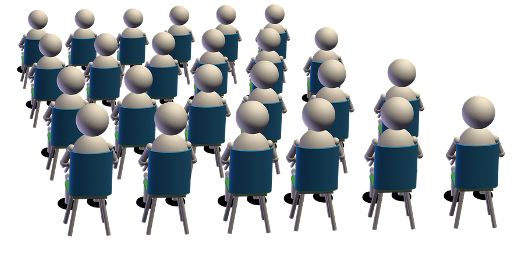

Saphyr and her friends are going to their local concert hall to see their favourite singer, Tinker Leisurely.
The rectangular hall is to be set up so that people sit in rows of chairs facing the stage. Each row will have the same number of seats, with each row having at most \(50\) seats. The hall has a capacity for at most \(115\) rows. Saphyr has discovered that there are to be \(4032\) seats for the audience.

Using what you know about the area of a rectangle and about the whole numbers that divide evenly into \(4032\), determine the possible configurations of seats in the hall.
If the stage is \(36\,\)m wide and the chairs are to be spaced \(1\,\)m apart (from centre to centre), which of your answers in part (a) do you think gives the most reasonable dimensions for the seating? Why?
We are looking for pairs of factors which have product \(4032\), thinking of the product as the number of seats in each row multiplied by the number of rows. We are given that each row must have at most \(50\) seats and we also know that there must be no more than \(115\) rows. Thus, one factor must be less than or equal to \(50\) and the other factor must be less than or equal to \(115\). The only possible such pairs with product \(4032\) are \(36 \times 112\), \(42\times 96\), and \(48\times 84\). Therefore, the hall could have \(112\) rows with \(36\) chairs in each row, or have \(96\) rows with \(42\) chairs in each row, or \(84\) rows with \(48\) chairs in each row.
Some students may list all possible products before checking constraints. They are: \(1\times 4032\), \(2\times 2016\), \(3\times 1344\), \(4\times 1008\), \(6 \times 672\), \(7\times 576\), \(8\times 504\), \(9\times 448\), \(12\times 336\), \(14 \times 288\), \(16 \times 252\), \(18\times 224\), \(21\times 192\), \(24\times 168\), \(28\times 144\), \(32\times 126\), \(36 \times 112\), \(42\times 96\), \(48\times 84\), \(56\times 72\), and \(63\times 64\).
Answers will vary.
Of the three possible arrangements, \(112\) rows of \(36\) seats would optimize the audience view of the stage, since the stage is \(36\,\)m wide. On the other hand, \(84\) rows of \(48\) seats would minimize the audience’s distance from the stage, but give a less optimal viewing angle for those on the outer edges of the seating. Thus, a good compromise with reasonable stage view and distance may be \(96\) rows of \(42\) seats.
Extension: If the rows did not have to have the same number of seats, how would your answer to part (b) change?